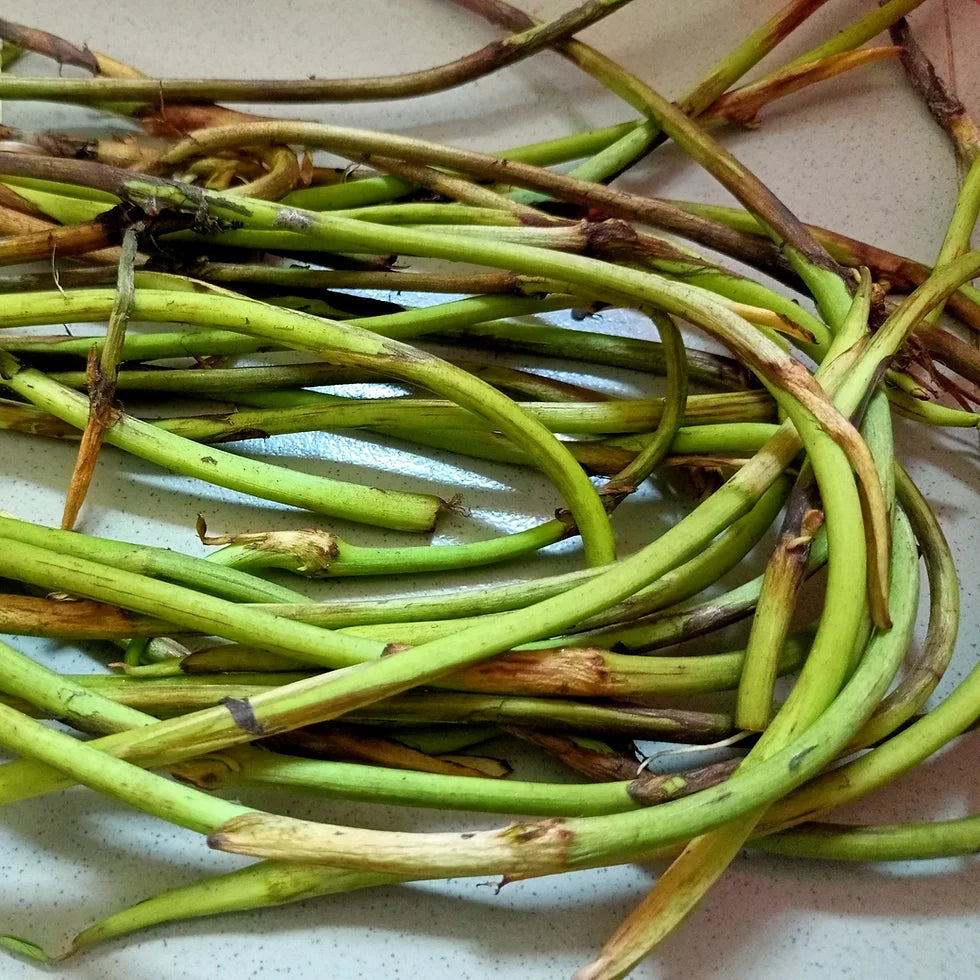Good Food Bar
Kochur Loti / Taro Stolon
Kochur Loti / Taro Stolon
Regular price
Rs. 269.00
Regular price
Rs. 399.00
Sale price
Rs. 269.00
Unit price
per
Couldn't load pickup availability
Taro stolons, also known as taro cormels or taro runners, are a part of the taro plant (Colocasia esculenta) that is used for propagation. They are essential for growing new taro plants. Here's a description of taro stolons:
1. Structure: Taro stolons are underground stems or runners that grow horizontally beneath the soil's surface. They are typically elongated and cylindrical, resembling small, segmented tubes.
2. Size: Taro stolons vary in size, but they are generally smaller in diameter than the main corm (the large, round underground tuber of the taro plant). The length of a stolon can range from a few inches to several feet, depending on the growth stage and environmental conditions.
3. Appearance: The outer surface of taro stolons is usually brown or tan, and it may have some fibrous or root-like structures extending from it. The inner flesh of the stolon is typically white, similar to the main corm.
4. Purpose: Taro stolons serve as the reproductive and propagation organs of the taro plant. Farmers and gardeners use stolons to grow new taro plants, as they can be planted in the soil to produce a new crop. Each stolon has the potential to grow into a mature taro plant if provided with suitable growing conditions.
5. Planting: To propagate taro using stolons, a section of the stolon is typically cut from the parent plant and planted in well-draining, moist soil. Under favorable conditions, the stolon will produce roots and shoots, eventually developing into a mature taro plant with leaves and corms.
6. Growth: Taro stolons contain stored energy and nutrients, which the new plant draws upon during its initial growth stages. As the new plant establishes itself, it develops its own corm, which will be harvested once mature.
7. Culinary Use: Unlike the main taro corm, taro stolons are not commonly consumed as a food item. They are primarily used for propagation and farming purposes.
Taro stolons play a vital role in the cultivation and propagation of taro, an important staple crop in many parts of the world, particularly in tropical and subtropical regions. The use of stolons allows farmers to continue growing taro plants from one generation to the next, ensuring a sustainable source of this versatile and nutritious root vegetable.
1. Structure: Taro stolons are underground stems or runners that grow horizontally beneath the soil's surface. They are typically elongated and cylindrical, resembling small, segmented tubes.
2. Size: Taro stolons vary in size, but they are generally smaller in diameter than the main corm (the large, round underground tuber of the taro plant). The length of a stolon can range from a few inches to several feet, depending on the growth stage and environmental conditions.
3. Appearance: The outer surface of taro stolons is usually brown or tan, and it may have some fibrous or root-like structures extending from it. The inner flesh of the stolon is typically white, similar to the main corm.
4. Purpose: Taro stolons serve as the reproductive and propagation organs of the taro plant. Farmers and gardeners use stolons to grow new taro plants, as they can be planted in the soil to produce a new crop. Each stolon has the potential to grow into a mature taro plant if provided with suitable growing conditions.
5. Planting: To propagate taro using stolons, a section of the stolon is typically cut from the parent plant and planted in well-draining, moist soil. Under favorable conditions, the stolon will produce roots and shoots, eventually developing into a mature taro plant with leaves and corms.
6. Growth: Taro stolons contain stored energy and nutrients, which the new plant draws upon during its initial growth stages. As the new plant establishes itself, it develops its own corm, which will be harvested once mature.
7. Culinary Use: Unlike the main taro corm, taro stolons are not commonly consumed as a food item. They are primarily used for propagation and farming purposes.
Taro stolons play a vital role in the cultivation and propagation of taro, an important staple crop in many parts of the world, particularly in tropical and subtropical regions. The use of stolons allows farmers to continue growing taro plants from one generation to the next, ensuring a sustainable source of this versatile and nutritious root vegetable.

